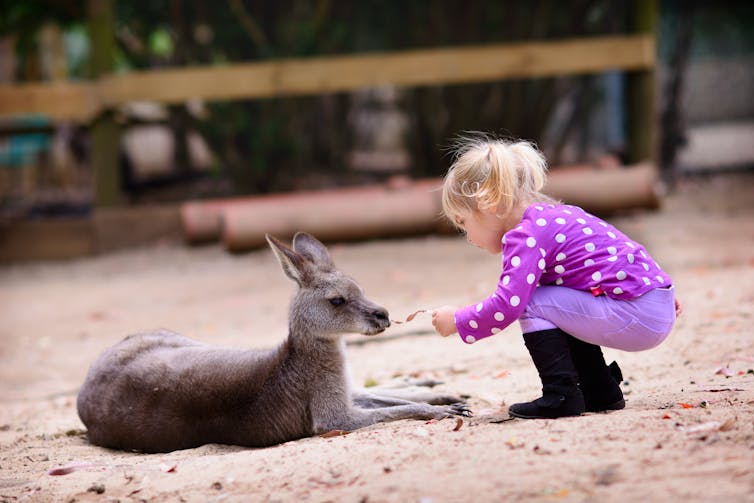
The authors are cultural men who have undertaken learning on and through Country with Elders in NSW, Queensland, and the Northern Territory. This piece is the product of their own experience and understanding and is not intended to represent the views of all Indigenous people.
As we acknowledge National Aboriginal and Torres Strait Islander Children’s Day, it’s important to recognise Indigenous Knowledge as vital to all children’s education.
When old Aboriginal people, like Kakadu Man Bill Neidjie and our cultural grandfather Damu Paul Gordon, say “I am Country, Country is me”, they are not speaking metaphorically. Our people have known for tens of thousands of years we come from the land, with our bodies composed of earth and water. The land is our big mother or Gunni Thakun, “Mother Earth” in the Ngemba language spoken by Damu Paul. If we damage her, we damage ourselves.
Environmentalist and academic David Suzuki reminds us modern science has also held evidence to support this narrative for more than 100 years. In The Sacred Balance: Rediscovering our Place in Nature, he points out 60-70% of our body weight is made up by water. Furthermore, every four to six weeks every one of these trillions of water molecules is replaced The remainder of our physical being is composed of molecules that come from the earth, through the food we consume. Essentially, we are all Country with a little stream running through us.
Read more: Invisible language learners: what educators need to know about many First Nations children
‘Country as teacher’
For three years, we have been working through the Centre for Sustainable Communities (University of Canberra), to reinvigorate this Country-centric approach to education within ACT schools. Through the Affiliated Schools program, a partnership between the ACT Education Directorate and the Faculty of Education at the University of Canberra, we have been privileged to work with 24 teachers from four schools to pilot and explore this “Country as teacher” approach in their classes.
This approach involved the students spending time on Country and focusing on sensory experiences. Preliminary findings (due to be published in late 2022) indicate early childhood and primary teachers find young children are taking to a Country-centric education quickly. They are able to sit, look and listen for long periods of time, and talk meaningfully with each other and their teachers about their experiences. Focusing on sensory experiences invariably led to curiosity about insects, birds, trees, weather, and seasons. This also strengthened their connection to each other and culminated in further inquiry-based learning in the classroom.
Teachers report the children are highly motivated to get back outside each day to continue their in-Country practice. Largely, it is the students who lead this aspect of their learning, with teachers operating as facilitators or guides. First Nations people reminded us for generations that children are born into their bodies deeply connected and curious, hungering to develop a relationship with Country. The project concludes in December 2022, but there are plans to grow the research through more ACT schools with a broader and deeper Country as Teacher research project through 2023 and beyond.

First Nations ways of learning for our young ones
For tens of thousands of years, Aboriginal children were born into knowledge systems based on Country - a Country-centric knowledge system. This involved learning about their connections to their respective Countries and Earth-kin (animals, plants, and geographical features that shared their place) in processes facilitated by their old people. These educational processes focused on cultural practices of looking and listening to Country to come to know, understand, and care for the places they inhabited.
Palyku academic Jill Milroy and her mother, Palyku Elder Gladys Milroy refer to this knowledge system as the “right story” and believe it to be the birthright of all Aboriginal children. They propose this story must become the birthright of all children born in Australia, as these connections to Country lie within us all. This is not to say all children are immediately welcome to sacred Indigenous knowledge, but First Nations peoples’ ethic of caring for Country is one all children, indeed, all people, must adopt if we are to meet the looming and omnipresent ecological, social and environmental challenges of our future.
The Dreaming Path by Damu Paul Gordon and Uncle Paul Callaghan argues the more children come to know about the places they inhabit, the more they will come to love Gunni Thakun and want to care for her. As their knowledge of connections with their Earth-kin expands and deepens, these connections become obligations.
An Ongoing Learning Journey
Most teachers in the Country as Teacher project with upper primary, secondary and college classes have reported greater difficulty in incorporating “relating with Country” practices in an already “overcrowded” curriculum. Despite this, they have nevertheless reported significant shifts in students’ mood and engagement, especially with previously disengaged students.
There is still significant work to be undertaken to truly “Indigenise” school curricula. However this will require the full engagement of an entire school. The project shows what is possible when teachers question mainstream methods and understand the value of First Nations knowledges to help improve students’ lives.
We are beginning to see what happens when people take the lessons of Bill Neidjie and our old people to heart. What happens when we accept ourselves as Country – with a little stream running through us?
Benjamin Wilson receives funding from The ACT Affiliated Schools Network
David Spillman does not work for, consult, own shares in or receive funding from any company or organization that would benefit from this article, and has disclosed no relevant affiliations beyond their academic appointment.
This article was originally published on The Conversation. Read the original article.







